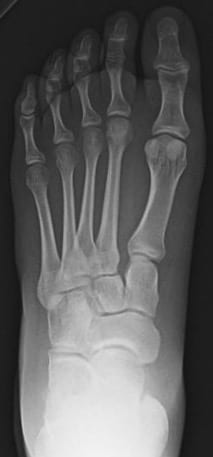ICE 009: Foot trauma
A 29 year old man stumbled into a gutter, tripped awkwardly and fell injuring his left foot. He has diffuse swelling and tenderness of the mid foot and is unable to weight bear on that limb.
Questions:
- Describe the abnormal findings on his x-ray
- What other x-ray findings may be seen and should be specifically sought in this type of injury ?
- What is the appropriate management in this case ?
Reveal the ICE answer
The x-rays show an abnormal separation between the 1st and 2nd metatarsals. At the base of these metatarsals the separation is as much as 5mm.
This injury is referred to as a “Lisfranc” injury. There are many types of Lisfranc injuries which can be caused by indirect force such as a rotational dorsiflexion mechanism, as in this case, or by direct force such as being run over by a car tyre. A classic mechanism is falling from a height and trapping or striking the foot such as off a ladder. Typically the metatarsals will drift laterally (as here) but displacement can be in any direction. There are often associated fractures of the metatarsal shafts or bases (especially the 2nd) and the there may also be fractures of the distal tarsals such as the cuneiforms and cuboid.
Lisfranc injuries should always be referred for specialist orthopaedic care. Very minor displacement may be able to be managed conservatively or with closed reduction but most cases need open reduction and internal fixation. Untreated the functional outcome from these injuries is very poor with chronic pain, abnormal gait and long term osteoarthritis.
Further Reading:
- Eponymictionary – Lisfranc injury
- Jacques Lisfranc de Saint-Martin (1787–1847)

ICE CASES
Ian’s clinical emergencies
emergency physician keen on medical education and cycling

